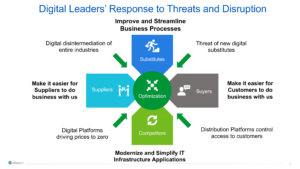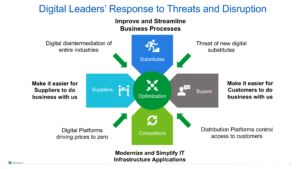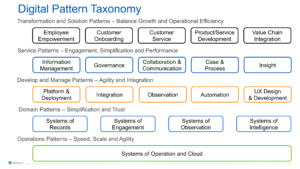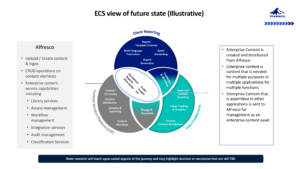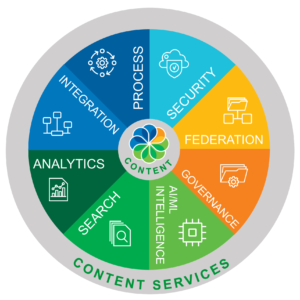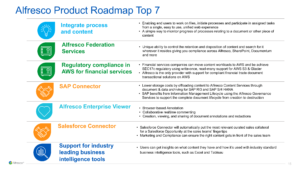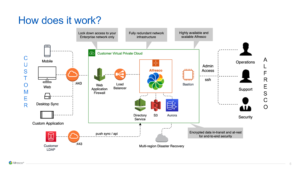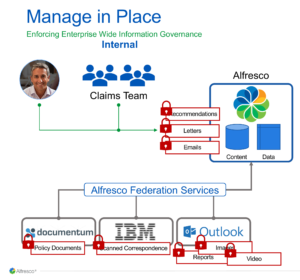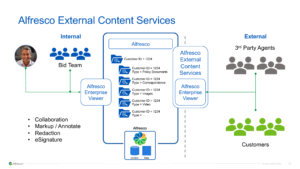Alfresco Modernize 2020
Blog: Column 2 - Sandy Kemsley
I’ve been attending the online Celonis conference for the past couple of days, but taking a break for Alfresco‘s short event, Alfresco Modernize. We started with an insightful keynote from CTO John Newton on patterns of digital transformation. As we likely enter a recession triggered by the global pandemic, he pointed out that most companies fail to execute properly through a recession, and showed some Harvard Business Review research on what actually works. This includes investing in digital transformation, decentralizing decision making, and being sure to retain knowledge and experience. The responses of digital leaders to disruptions such as what we’re now seeing focus on improving business processes, modernizing infrastructure, and making it easier to connect with customers and suppliers.
He discussed the concept of digital transformation patterns that can be derived from successful journeys, such as customer onboarding or improving manufacturing operations. He addressed the different layers of patterns shown in the chart at the left, and how they interact. We’ve used patterns in software development for a long time, and Newton shows us that it’s time to start documenting, understanding and applying digital transformation patterns. Alfresco wants to start documenting these in a very open source manner, and create solutions to address the common patterns.
Up next was a presentation by Dinesh Selvakumar, Global Head of Enterprise Content Management at Invesco, a global investment management firm. They are a relatively new Alfresco ECM customer, implementing in their own AWS instance during 2018-2019, and migrated content from other systems. They still have a lot of content silos, plus ad hoc routing and approval workflows, and have created an ECM CoE to improve standardization and governance. They want to integrate their systems to provide a unified user experience, and moved from an ECM mindset to that of Enterprise Content Services (ECS) that provides unified capabilities across the disparate platforms. They realize that there are some content and collaboration platforms that they’re never going to get rid of, but still need to have them integrated into the big picture connected by Alfresco. Eventually, enterprise content may be created in other applications, but then sent to Alfresco for enterprise-level management. They are quantifying the benefits of the move to an ECS, although some of the benefits are difficult to measure, such as decreased time searching for content. He shared some of the lessons that they learned and their key success factors, several of which are based on having a global focus and deployment.
Tony Grout, Alfresco Chief Product Officer, provided a product roadmap for their digital business platform. I found the slide on content and process interesting, in that it mentioned “processes relating to a document”: it seems like they have really trimmed off any of the pure process management messaging that they had previously, although Alfresco Process Server (Activiti) is still alive and well. Part of their core value proposition is the ability to start with open source and transition to the fully-supported (and more functional) enterprise version: this is true of any commercial open source vendor, but it’s front and center with Alfresco.
There are a number of new features on the roadmap: Federation Services (launching today) to federate different repositories, managing content in place instead of having to migrate everything to Alfresco; regulatory compliance in AWS; and the Enterprise Viewer that we saw demoed a bit later. Some of these capabilities likely came from their acquisition of Technology Services Group, a former Alfresco partner that built out a lot of value-added functionality.
Mark Stevens, General Manager for the Alfresco Cloud, introduced how they are rolling out the Alfresco Digital Business Platform as a service, and why cloud provides such great benefits for content management: resiliency, availability, and lower costs. Their platform is cloud-native, not just a containerized version of an on-premised platform, which provides better scalability and extensibility. Removing most of the overhead from managing an ECM platform means that you have more time (and money) for more innovation and digital transformation. He walked us through their overall architecture, and what a typical implementation would look like, in terms of what’s managed by the customer and what’s managed by Alfresco. They’ve had some pretty high-profile wins over other ECM vendors, such as OpenText Documentum and IBM FileNet, with transitioned customers seeing a lot of hard benefits from Alfresco Cloud.
Last up in this short event were Paul Hampton, Senior Director of Product Marketing, and Ben Allen, Technical Architect, talking about the new Federation Services and Enterprise Viewer products that were announced earlier by Tony Grout. These are both pretty significant new capabilities: Federation Services allows all content repositories to be federated through Alfresco, so that users have a single user experience, and all of the sources can be managed directly by policies set in Alfresco. Content is managed in place rather than all migrated into Alfresco, although in some cases this will likely be a first step on the way to a migration.
We saw a demo of the Enterprise Viewer, which has a lot of interesting capabilities for both internal and external participants. It’s fast to browse and load large document sets, and to individual large documents since they’re caching across the network by page. Documents can be redacted for external participants, for example, removing personal information from an insurance claim when sending to an external party for a repair quote. Video can be annotated to add comments at specific points to highlight certain things in the video, with the ability to jump directly to the point of the comment. Annotations are collaborative, so that a user can reply to an existing annotation.
I didn’t stick around for the live Q&A since I wanted to get back to CelosphereLive for a session starting at the same time. Alfresco Modernize didn’t have much of a “live” feel to it: the sessions were all pre-recorded which, as I’ve mentioned in my coverage of other online conferences, just doesn’t have the same feel. Also, without a full attendee discussion capability, this was more like a broadcast of multiple webinars than an interactive event, with a short Q&A session at the end as the only point of interaction. To their credit, each speaker was in their own home, practicing social distancing; although I liked the Celonis studio environment, I did feel that it’s a bit too early to have people in the same location for an event, no matter how controlled.
Leave a Comment
You must be logged in to post a comment.
